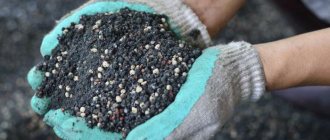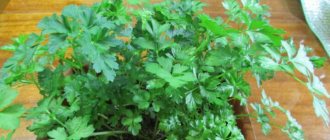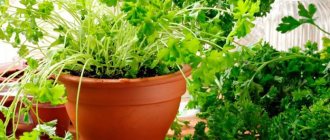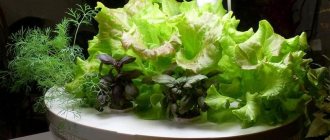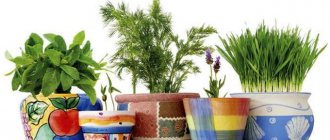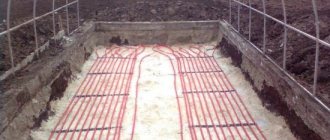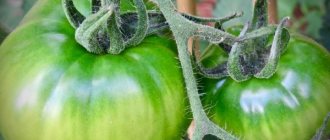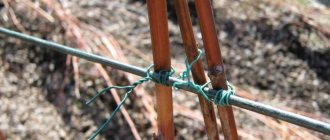Daria Vorontsova
Reading time: 5 minutes
AA
Many varieties and varieties of lettuce can be grown year-round at home.
Green leaves serve as a decoration for prepared dishes and as a basis for salads and sandwiches.
The shoots contain a large amount of vitamins and minerals, while being low in calories.
Growing lettuce on a windowsill requires the use of special knowledge and agrotechnical techniques that allow you to get a good harvest even in winter.
Main types of lettuce
When choosing seeds, preference should be given to varieties for indoor soil with early ripening, resistant to bolting and short daylight hours. The most popular varieties of lettuce that can be grown in an apartment:
- Iceberg . This is the type of salad that chefs use to make Caesar salad. Neat heads of cabbage with crispy, juicy leaves retain their nutritional value and presentation for a long time. Iceberg is cold-resistant and demanding of light and humidity levels. Heads of cabbage reach 8-10 cm in diameter.
- Lettuce . The green or burgundy leaves are collected in a rosette up to 15 cm high. The salad contains a large amount of potassium and iron. The greens have a slight bitterness and a delicate nutty flavor.
- Romano . Loose heads of cabbage with oblong leaves reach a mass of 300 g. The top with wavy edges curls inward. It is used both fresh and after heat treatment. The leaves have a rich taste with a characteristic mustard-nut aftertaste.
- Arugula . The smooth, elongated leaves resemble the shape of a dandelion. Thanks to essential oils, it has a spicy aroma and rich taste. Valued for its high content of vitamin C and iodine. Used for preparing salads and meat dishes.
- Oakleaf (Oakleaf) . Decorative leaves are collected in a spreading variegated rosette. Color varies from soft green to red-brown. Oakleaf is demanding of care and requires a spacious bowl and constant temperature conditions.
Most leafy lettuces go well together in taste, so you can choose several varieties for your home garden on the windowsill. In this case, it is advisable to select varieties with similar requirements for growth conditions.
What types and varieties of lettuce are suitable for growing on a windowsill in winter?
Growing lettuce in winter requires good additional lighting. Lettuce does not tolerate dry air, such as from heating radiators, or excessive heat: this causes its leaves to become bitter and flowering occurs prematurely. Headed forms are especially capricious in this regard: it is better for inexperienced gardeners not to undertake their cultivation.
The standard variety for growing indoors is Batavia, a lettuce that can most often be found in grocery stores in winter. This variety is one of the most unpretentious in terms of temperature and humidity, as well as the duration of lighting. Other varieties suitable for indoor growing include, for example, Lollo Rossa, Lollo Biond, New Year, Emerald Lace, etc.
Batavia is one of the most unpretentious varieties of lettuce
Lollo bionda is perhaps one of the most beautiful head lettuces with wavy yellowish-green leaves. Lolla Rossa is one of the most vitamin-rich varieties, with leaves whose color changes from light green at the bottom to red-brown at the tops, and the taste has a nutty aftertaste. New Year's is shade-tolerant; it can also be kept on windows facing north. Emerald lace is a salad characterized by a long period of use of leaves.
Lollo Rossa - a variety of lettuce with a high iodine content in the leaves
In addition to the usual well-known varieties of leaf and head lettuce, watercress is often grown on the windowsill. True, not everyone likes its taste, but you can get vitamin greens with a minimum of effort. Watercress grows quickly, and does not even necessarily require soil. It can be cultivated on hydrogel and on regular cotton wool. He also has varieties, for example, Curly, Broad-leaved, Ordinary, etc.
What you need to grow lettuce
In order to start growing lettuce at home, you need to prepare the appropriate container, soil and planting material. The timing of sowing seeds depends on the varietal characteristics of the crop. Light-loving varieties are recommended to be planted in spring and summer. In conditions of short daylight hours, characteristic of autumn and winter, it is better to plant shade-tolerant varieties.
Selection and preparation of containers
The shallow root system of the crop allows you to choose shallow bowls or containers for planting. A mandatory requirement is the presence of holes for excess water to escape.
Ceramic, plastic or clay containers can be used as containers. Before planting, the containers must be washed and disinfected with potassium permanganate.
At the bottom of the container it is necessary to lay a layer of drainage made of expanded clay, bitumen or small stones.
It is advisable to provide the bowl with a tray into which liquid will drain after watering.
Preparing lettuce seeds for planting
Planting material is purchased in specialized stores, giving preference to reliable manufacturers. When purchasing, you should pay attention to the expiration date of the seeds and the integrity of the packaging. Granulated seeds do not require pre-sowing preparation. All necessary measures have already been taken by the manufacturer. Only self-harvested seeds should be processed. In this case, they are placed in a weak solution of potassium permanganate for 1 hour.
Creating the necessary conditions
Most lettuce varieties need good light. To grow greens at home, choose the sunniest place in the apartment. It is advisable to provide plantings with protection from drafts and sudden temperature changes during the day.
To grow juicy, elastic greens, it is necessary to maintain a high level of air humidity. During the heating season, bowls with lettuce should not be placed close to radiators. The ideal place for a home garden is the kitchen window sill. In the summer months, you can place a container of herbs on a loggia or balcony.
The soil for salad should consist of turf and leaf soil in equal proportions. To loosen it, it is advisable to add coarse sand. It is not advisable to use peat, as it increases the acidity of the soil.
About the beneficial properties of salad
In particular, speaking about the benefits of salad, it should be noted that one hundred grams of this plant contains up to fifty milligrams of vitamin C.
Other beneficial substances include:
- folic acid;
- sodium;
- iron;
- iodine;
- potassium;
- zinc.
The presence of folic acid in salad makes it necessary in the diet of people of any age. It is especially useful for those who want to conceive a child, since this acid has a positive effect on the human reproductive system.
In addition, it should be noted the presence of a substance such as lactucin, which has a lot of beneficial effects:
- calms the nervous system;
- reduces the level of salts deposited in the body;
- harmonizes sleep.
Lettuce growing technology
The future harvest largely depends on well-organized planting of seeds and care of seedlings in the first days after germination. The planting technology consists of the following steps:
- The container with the drainage layer is filled with soil, not reaching 2-3 cm to the top edge;
- The soil is moistened and slightly compacted with a tablespoon;
- Carefully distribute the seeds over the soil surface in accordance with the planting scheme recommended by the manufacturer;
- Sprinkle 0.5 - 1 cm with the remaining soil, spray with warm water from a spray bottle and cover with cling film or glass.
Until the first shoots sprout, maintain the temperature at 20-22 °C. As soon as shoot loops appear on the surface, remove the cover and reduce the temperature to 16-18 °C. Cool air protects the sprouts from being pulled and prevents the formation of flower shoots.
Helpful information
Daria Vorontsova
Amateur gardener. He is interested in growing various greens at home.
The root system of lettuce does not adapt well when transplanted, so it is not picked. To avoid thickening, seeds are sown at the distance indicated on the package.
How to sow lettuce at home
Different types and varieties of lettuce have their own requirements for temperature, lighting, nutrition, etc., but in general they do not differ much, and for growing in a city apartment there is a single method that meets the needs of most varieties.
Many varieties of lettuce grown in an apartment in winter are early ripening, so to ensure constant production, they are sown every two weeks.
Salads are grown in wooden or plastic boxes of any size with holes in the bottom, and in separate pots. For large-headed varieties, pots are more convenient; for leafy varieties, boxes are more convenient. For different varieties, the optimal container height can be 10–15 or 30–35 cm: you need to look at the seed packaging in advance for the variety’s preferences regarding the height of the soil layer. But in any case, the containers are placed in trays where excess water flows during irrigation. And in any box or pot, a layer of 2–5 cm of drainage is placed at the bottom: made of small pebbles or expanded clay.
There is also a “modern” approach to organizing drainage: many amateurs, instead of expanded clay or pebbles, place a layer of synthetic padding on the bottom of the salad container.
Salads are not very demanding on the composition of the soil. You can buy ready-made soil in the store, or you can prepare it yourself. The best composition is turf soil, sand and humus in equal parts. It is important that the soil is not too acidic. If the soil is taken from the garden, it should be disinfected before use by spilling it with a pink solution of potassium permanganate. Fill the containers with soil, just short of their edges.
Sowing is not difficult, but to speed up the emergence of seedlings, the seeds are often pre-soaked for a day in ordinary water, and if they are not from a reliable source, then they are pickled for 15–20 minutes in a dark solution of potassium permanganate. Sow lettuce in pre-watered furrows to a depth of about 1 cm. Sow often, perhaps every centimeter: not all seeds will sprout, then thinning is carried out. The seeds are carefully covered with soil, lightly compacted and the containers are covered with glass or plastic film.
You don’t have to make furrows, but scatter the seeds and then sprinkle them with a centimeter layer of soil
Place the covered containers in a warm place (the salad will rise at 15 °C, but at 26–28 °C this will happen much faster). Periodically, the glass is lifted for ventilation. Shoots may appear as early as the 4th or 5th day. The garden is immediately transferred to a well-lit windowsill and the glass is removed. At first, you need to protect the seedlings from bright sunlight, then it will be easier.
Plant care
When 2 true leaves appear on the sprouts, thin out the seedlings. The strongest seedlings are left, with a thick stem and large leaves. If necessary, repeat the procedure after 1 week. As a result, each seedling must have enough area in the bowl for normal development and uniform lighting. It is recommended to rotate the salad container by 45° every week.
Weeds should not be allowed to sprout as they draw most of the nutrients from the soil.
Watering
Timely and abundant soil moisture is the main procedure for caring for greenery. It is necessary to water in the morning, after allowing the water to stand for 24 hours. The roots of the plant should always be in slightly moist soil. Lack of moisture causes the leaves to become bitter. In hot weather and during the heating season, you should spray the ground part with warm water 1-2 times a day.
Top dressing
Leaf lettuce usually has a short ripening period. The nutrients contained in the soil are sufficient to form a full-fledged harvest. In case of slow growth and the formation of thin, pale leaves, you can apply organic fertilizer based on humate. Keep in mind that fertilizing with mineral fertilizers leads to the accumulation of nitrates in plants.
Harvesting
An hour before harvesting, I water the bushes with water, completely cut off the leaves, leaving the root. Then I feed it with urea to harvest it 2 more times. Cut off the leaves immediately before eating or preparing a vitamin salad.
Lettuce was harvested and sorrel grew in the garden. Read, I told you how to store sorrel at home to use for food in winter.
The lettuce has grown and is cut with a knife or scissors.
Diseases and pests
Salad fly larvae
Aphid
Calcining the soil in the oven
Onion-garlic solution against pests
In apartment conditions, lettuce rarely suffers from pest invasion. Insect damage is possible if garden soil with larvae of lettuce flies or aphids is used. For prevention, you should calcinate the soil in the oven or spill it with a solution of potassium permanganate. If the pest has spread throughout the plantings, it is recommended to spray the leaves with an infusion of garlic or onion peels.
In conclusion
As you can see, lettuce is not only healthy, but also quite easy to grow. Even on the windowsill you can get a good harvest of greens, thereby diversifying your diet in severe frosts, when vitamins are sorely lacking.
Sources
- https://mir-ovosey.ru/vyrashhivanie-salata-na-balkone/
- https://zifrik.ru/kak-vyrastit-salat-na-podokonnike/
- https://oteplicah.com/rasteniya/419-parnikovyj-salat-moskovskij
- https://openfile.ru/bez-rubriki/%D1%81%D0%B0%D0%BB%D0%B0%D1%82-%D0%BD%D0%B0-%D0%BF%D0%BE %D0%B4%D0%BE%D0%BA%D0%BE%D0%BD%D0%BD%D0%B8%D0%BA%D0%B5-%D0%B2%D1%8B%D1%80% D0%B0%D1%89%D0%B8%D0%B2%D0%B0%D0%BD%D0%B8%D0%B5-%D0%B8%D0%B7-%D1%81.html
- https://balkonsami.ru/interer/ozelenenie/vyirashhivanie-zeleni-na-balkone-i-podokonnike.html
- https://ogorod365.com/posadka-salata-v-2020-godu-sroki-poseva-vyrashhivanie-i-uhod/
[collapse]
Growing lettuce
How to grow lettuce on your windowsill at home? Prepare a container with a depth of about 10-12 cm. The selected tray should be wide. Otherwise, the plant's roots will suffer from lack of moisture. Place the seeds in the soil to a depth of no more than 0.7 cm. Pre-moisten the soil. Cover the tray with a layer of plastic wrap. Then move the container to a moderately cool place. After waiting for the first shoots to appear, remove the film. Place the container on a well-lit windowsill. Water the salad every two days. Avoid prolonged exposure of seedlings to direct sunlight.

